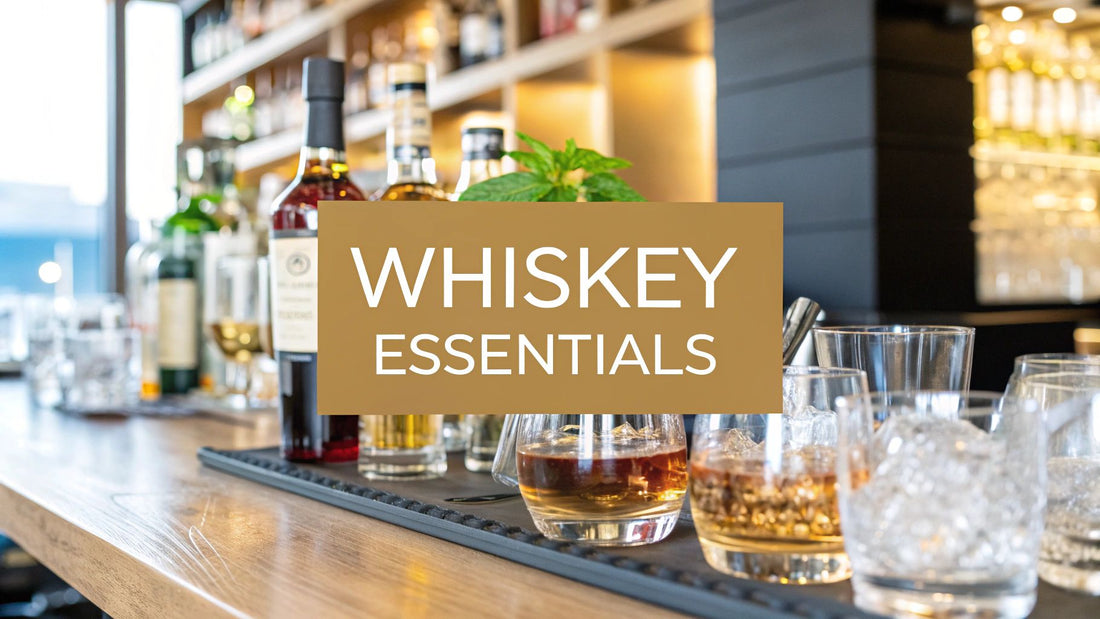Whiskey can seem intimidating with its own set of rules and rituals, but the truth is simpler: the best way to drink it is the way you enjoy it most. For newcomers, the challenge is not following rules, but discovering what that personal preference actually is. This guide is your map, clearly outlining the seven fundamental ways to drink whiskey so you can find your perfect pour. Forget the confusing jargon and gatekeeping; we are focused on practical, actionable methods that empower you to explore with confidence.
We will move beyond generic advice, offering specific techniques for each serving style, from drinking it neat to crafting a highball. You'll learn how ice, water, and mixers fundamentally change the tasting experience. Each method will be paired with insights into how different types of spirits, especially from innovative American craft distilleries like Laws Whiskey House or Westward Whiskey, can shine in various preparations.
Whether you're pouring a dram from a well-known brand or exploring a curated selection from a service like Blind Barrels, which champions small-batch producers, this list provides the tools you need. Our goal is to help you taste, experiment, and confidently order or prepare your next glass, ensuring every sip is a rewarding one.
1. Neat (Straight)
Drinking whiskey neat, or straight, is the most traditional way to appreciate the spirit. This method involves serving a measure of whiskey in a glass at room temperature, completely unadulterated by ice, water, or mixers. It’s the purist's approach, designed to deliver the whiskey exactly as the distiller crafted it. This allows for a full sensory evaluation of the spirit’s complex aromas, nuanced flavors, and the characteristic warmth from the alcohol.
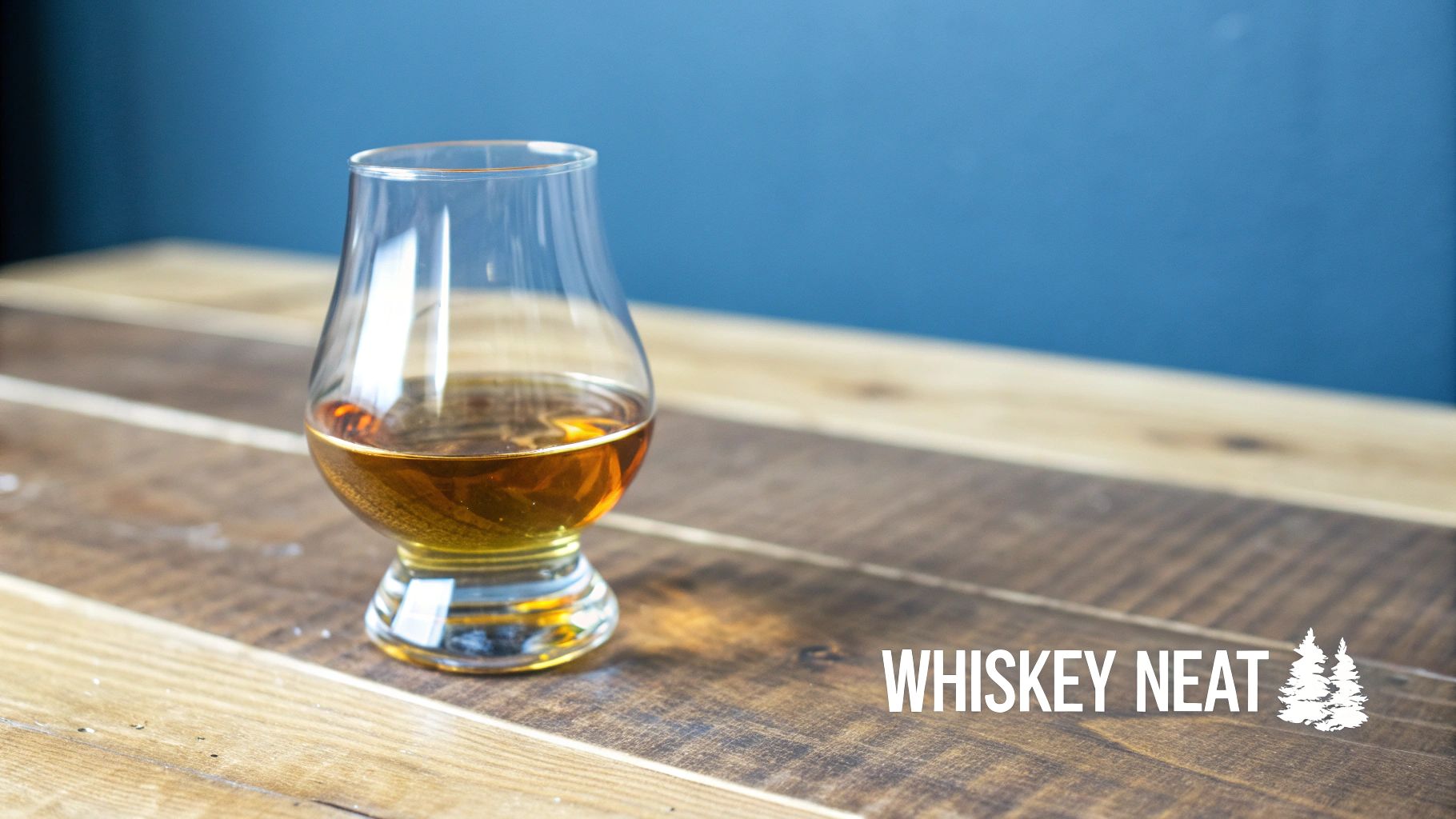
This method is the gold standard at distillery tastings, whiskey judging competitions, and high-end bars serving rare bottles. The goal is to isolate the whiskey’s unique character, from a smoky Islay Scotch to a sweet, corn-forward American craft bourbon from a distillery like New Riff.
How to Drink Whiskey Neat
To fully appreciate a neat pour, the right technique and glassware are key. A Glencairn or tulip-shaped glass is ideal, as its shape concentrates the aromatic compounds, funneling them toward your nose.
- Let it Breathe: After pouring, allow the whiskey to rest in the glass for a minute or two. This lets the initial, harsher alcohol vapors dissipate, revealing more subtle underlying notes.
- Nose Gently: Bring the glass to your nose, but keep your mouth slightly open. This simple trick helps mitigate the alcohol burn and allows you to detect a wider spectrum of aromas.
- Take Small Sips: The first sip should be small, coating your tongue and palate. This acclimates your mouth to the alcohol proof. Subsequent sips will reveal more complex flavors like caramel, vanilla, oak, or spice.
- Palate Cleansing: Keep a glass of room-temperature water nearby to cleanse your palate between different whiskeys, ensuring each one is experienced without interference.
New Drinker Tip: If you're new to drinking whiskey neat, start with lower-proof options (around 40-43% ABV) or sweeter styles like a wheated bourbon. This helps your palate adjust to the intensity without being overwhelmed.
Drinking neat is the ultimate way to engage with a whiskey's story. It connects you directly to the distiller's vision, making it an essential experience for anyone exploring the diverse world of whiskey. For more insights on finding your preferred method, explore our guide on the "right" way to drink whiskey.
2. On the Rocks (With Ice)
Serving whiskey "on the rocks" involves pouring a measure of whiskey over ice cubes, typically in an old-fashioned or rocks glass. As the ice slowly melts, it both chills and dilutes the spirit. This process can significantly mellow the harshness of high-proof whiskeys, making them more approachable while simultaneously unlocking subtle flavors that might otherwise be masked by the alcohol's intensity. It’s one of the most popular ways to drink whiskey, especially within American whiskey culture.
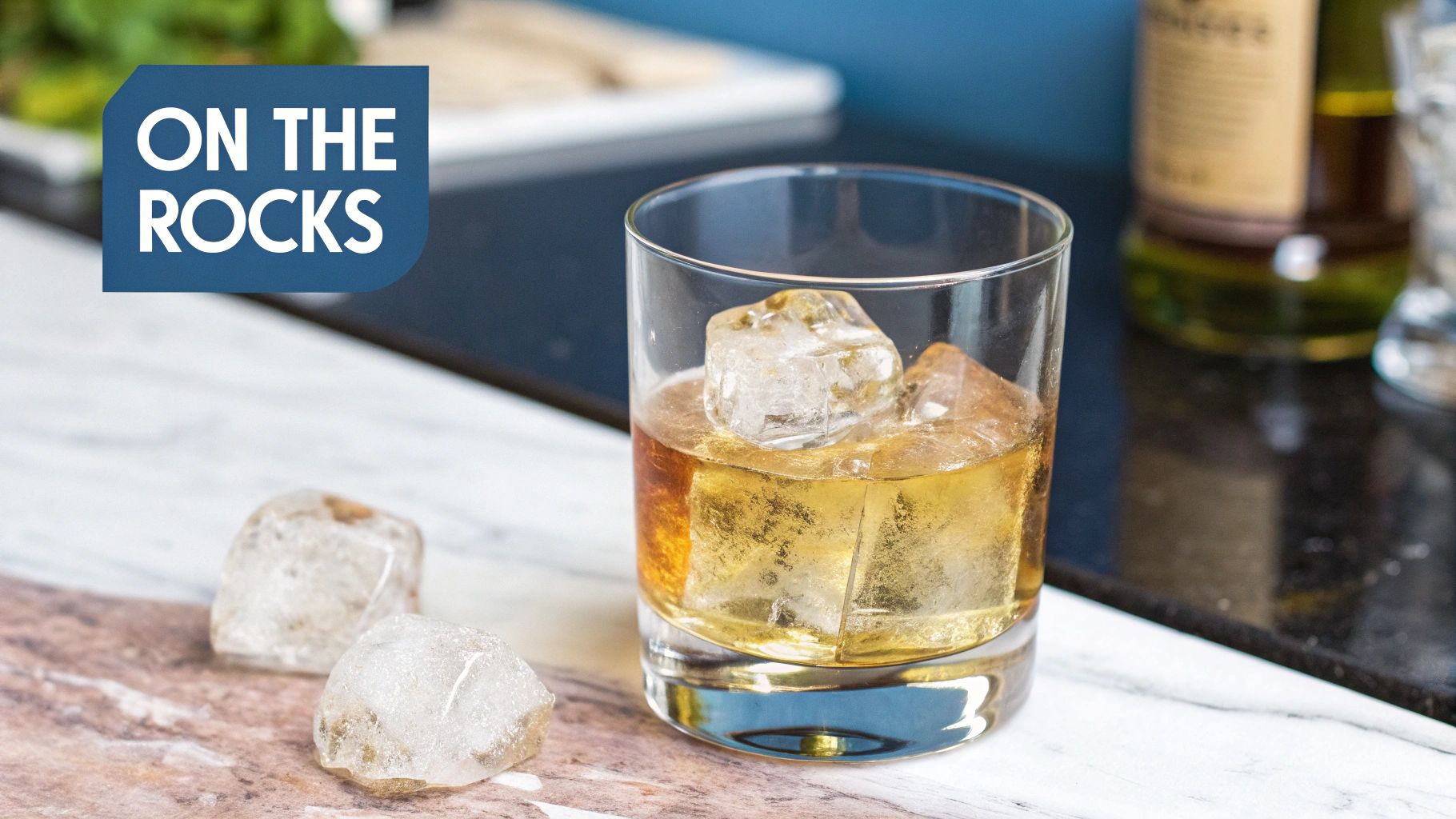
This method became an iconic symbol of cool in classic Hollywood films and was famously preferred by figures like Frank Sinatra and the Rat Pack. It remains a standard serve at countless bars, from local dives to upscale lounges, and is particularly well-suited for robust American craft whiskeys like a high-rye bourbon from Balcones, whose bold flavors can stand up to a bit of chilling and dilution.
How to Drink Whiskey on the Rocks
To get the most out of a whiskey on the rocks, the quality and shape of your ice are paramount. The goal is to chill the spirit effectively without over-diluting it too quickly.
- Use Large Ice: Opt for large, dense ice cubes or spheres. Their smaller surface-area-to-volume ratio means they melt much more slowly than standard ice cubes, chilling your whiskey with minimal dilution.
- Choose Quality Water: For the purest taste, make ice from filtered or distilled water. This prevents any off-flavors from tap water from interfering with the whiskey’s profile.
- Let it Temper: After pouring, allow the whiskey to sit for about a minute. This gives the ice time to slightly chill the spirit, allowing the flavor profile to evolve as you sip.
- Start with Robust Whiskeys: This method works best with higher-proof or boldly flavored whiskeys, such as a spicy rye or a rich, cask-strength bourbon. The ice helps tame their heat and can reveal sweeter notes. Avoid using it for delicate, older, or more nuanced spirits, as the cold can mute their complexity.
New Drinker Tip: If you're just starting out, a single large ice cube can be the perfect bridge from cocktails to drinking whiskey neat. It slightly cools and dilutes the spirit, making a 90-proof bourbon much more palatable without masking its core character.
Drinking whiskey on the rocks is a fantastic way to enjoy a bolder spirit in a relaxed setting, especially on a warm day. It provides a refreshing experience while softening the alcohol's bite, making it an excellent choice for anyone exploring the powerful flavors of American craft whiskeys. For more on how dilution impacts flavor, check out our guide on adding water to whiskey.
3. With Water (Diluted)
Adding a few drops of water to whiskey is a time-honored technique used by master blenders and seasoned enthusiasts to unlock the spirit’s full potential. This method involves diluting the whiskey with a small amount of room-temperature water, which triggers a chemical reaction that can significantly alter its aroma and taste. The addition of water reduces the alcohol concentration, taming the “burn” and allowing more delicate, subtle flavor compounds to come forward.
This practice is standard at professional tastings and is deeply ingrained in Scottish whisky tradition, where distillers often provide water from their local source. It is particularly effective for high-proof or cask-strength expressions, like many of the unique American craft whiskeys from distilleries such as Westland featured in Blind Barrels boxes. Dilution makes these powerful spirits more approachable and reveals hidden layers of complexity that might otherwise be masked by the high alcohol content.
How to Drink Whiskey With Water
Precision is key when adding water; too much can drown the spirit, while too little may not have a noticeable effect. Using the right tools and water type ensures you enhance the whiskey rather than detract from it.
- Start Small: Begin by adding just two or three drops of water using a pipette or straw. This small amount is often enough to open up the whiskey’s aromatics.
- Swirl and Rest: Gently swirl the glass and let it sit for about 30 seconds. This allows the water and whiskey to fully integrate before you taste.
- Use Quality Water: Avoid tap water, which can contain chlorine and other minerals that will alter the whiskey's taste. Opt for spring or distilled water. For those who prefer a slight dilution, the type of water can subtly influence the flavor profile, making choosing the right water for dilution a difference in the overall experience.
- Taste and Adjust: Nose the whiskey again, then take a sip. You may notice new notes of fruit, florals, or spice. If the alcohol still seems too prominent, add another drop or two and repeat the process.
New Drinker Tip: For cask-strength whiskeys (often 55% ABV or higher), don't be afraid to add water. The goal is to find your personal sweet spot where the alcohol burn fades and the flavors pop. Trust your own palate, not a rulebook.
Adding water is one of the most effective ways to drink whiskey for analytical tasting. It empowers you to customize the spirit’s intensity and explore the full spectrum of its flavors, making it an essential skill for any curious drinker.
4. Whiskey Cocktails
Incorporating whiskey as the base spirit in mixed drinks is one of the most versatile and popular ways to drink whiskey. This method transforms the spirit by combining it with ingredients like bitters, sugars, citrus, or vermouth, creating a balanced and complex beverage. Classic cocktails like the Old Fashioned and Manhattan have been staples for over a century, showcasing how well whiskey’s character can be complemented or highlighted.
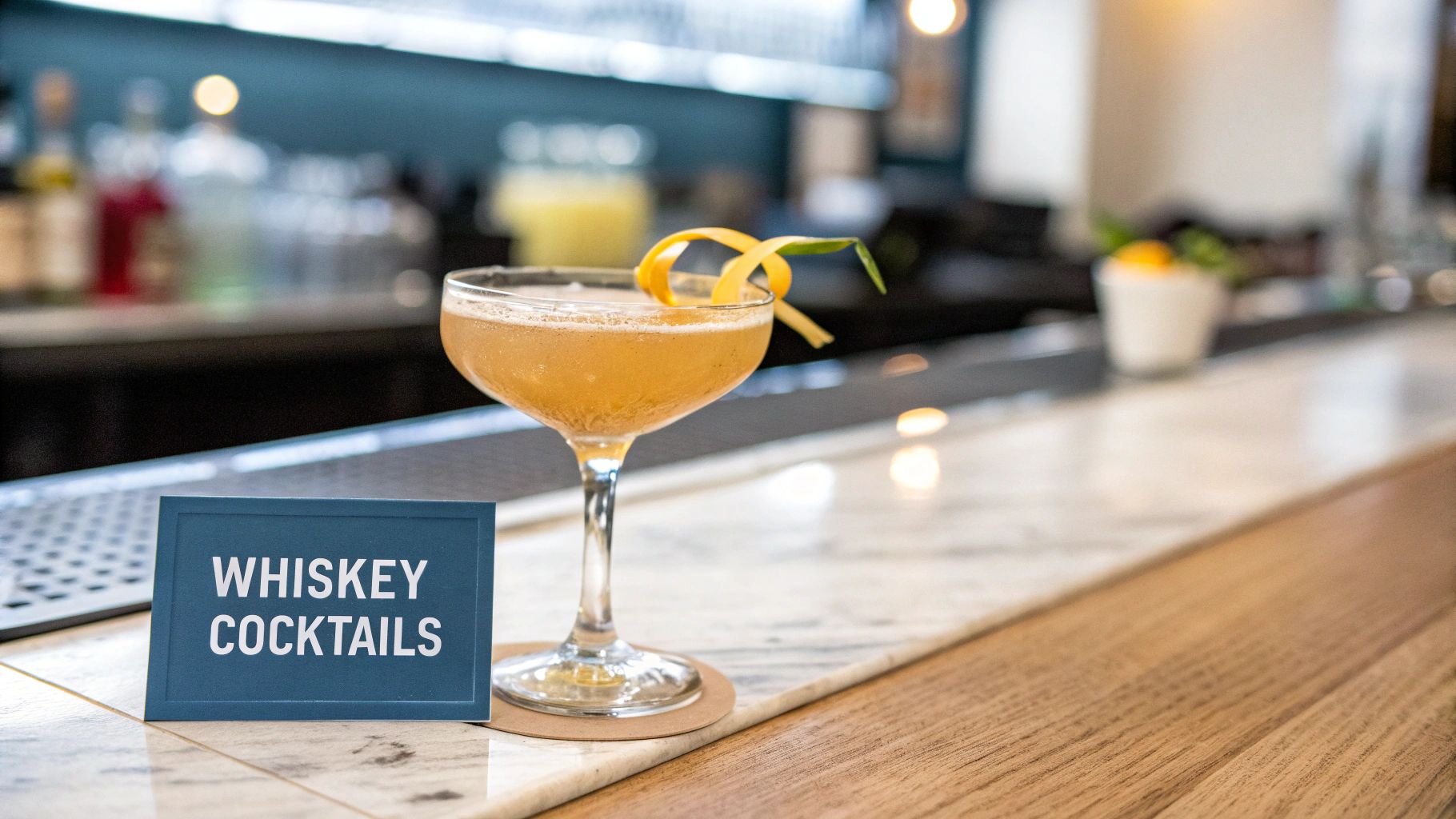
From Prohibition-era speakeasies to the modern craft cocktail revival, mixed drinks have made whiskey accessible to a wider audience. They can mellow a high-proof spirit or accentuate specific flavor notes, making them an excellent choice for both newcomers and seasoned enthusiasts. A well-made Whiskey Sour using a bright, fruity American single malt from a producer like Stranahan's demonstrates the incredible range whiskey offers beyond a simple pour.
How to Make Great Whiskey Cocktails
Crafting a quality whiskey cocktail is about balance and technique. Using fresh ingredients and the right tools will elevate your mixed drinks from good to exceptional.
- Choose the Right Whiskey: You don't need your most expensive bottle, but quality matters. A solid mid-range American craft bourbon or rye provides enough character to stand up to other ingredients without getting lost.
- Use Fresh Ingredients: Freshly squeezed lemon or lime juice is non-negotiable. It provides a brightness that bottled juices simply cannot replicate.
- Master the Technique: Learn when to stir and when to shake. Stir cocktails that are all spirits (like an Old Fashioned or Manhattan) to achieve a smooth, silky texture. Shake cocktails with citrus, egg white, or cream to properly emulsify and aerate them.
- Chill Your Glassware: Serving your cocktail in a chilled glass keeps it at the optimal temperature for longer, ensuring the first sip is as good as the last.
New Drinker Tip: Start with a simple two-ingredient cocktail like a Whiskey Ginger or a three-ingredient one like a Whiskey Sour. This helps you understand how whiskey interacts with sweet and sour elements before moving to more complex recipes.
Whiskey cocktails offer a creative way to explore different flavor profiles and find new appreciation for the spirit. Discover more ways to use small-batch spirits in our guide to craft whiskey cocktails.
5. With a Whiskey Stone or Steel Cube
For those who enjoy a chilled whiskey but dislike the dilution from melting ice, whiskey stones or steel cubes offer a modern solution. This method involves adding pre-frozen, non-porous cubes made from materials like soapstone, granite, or stainless steel directly to your glass. They lower the spirit’s temperature without adding water, preserving the whiskey's original flavor profile and proof as intended by the distiller. It’s an innovative approach that provides a chilled sip while maintaining the integrity of the spirit.

This method has become a staple in modern whiskey culture, popularized by brands like the original Whiskey Stones and frequently featured as a premium option in upscale bars. They are especially popular for enjoying robust American craft whiskeys where you want to temper the alcohol heat slightly without muting the rich corn and oak notes.
How to Use Whiskey Stones
Using whiskey stones effectively requires a little preparation, but the process is simple. Unlike ice, they provide a gentler, more sustained chill that doesn't "shock" the spirit.
- Freeze Thoroughly: Place the stones or cubes in their storage pouch and freeze them for at least four hours. This ensures they reach a low enough temperature to be effective.
- Use the Right Amount: Add two to three stones to your glass before pouring the whiskey over them. This provides the optimal surface area for chilling a standard 1.5 to 2-ounce pour.
- Choose Your Material: Stainless steel cubes, often filled with a non-toxic freezing gel, tend to chill the whiskey more quickly and effectively than soapstone or granite.
- Sip Promptly: Whiskey stones are best for sipping within 20 to 30 minutes, as their cooling effect is more subtle and less lasting than ice. Always rinse and dry them before returning them to the freezer.
New Drinker Tip: Whiskey stones are a great tool for newcomers who find neat pours too intense but want to avoid dilution. It gently cools the spirit, making it more approachable while preserving the complex flavors of a craft bourbon or rye.
Using whiskey stones is a stylish and practical way to enjoy a chilled dram, ensuring your last sip is just as potent and flavorful as your first. It's an excellent technique for appreciating the undiluted character of a well-crafted spirit at a slightly cooler temperature.
6. With a Mixer (Highball Style)
Mixing whiskey with a non-alcoholic beverage is one of the most accessible and refreshing ways to enjoy the spirit. This method involves combining whiskey with mixers like soda water, ginger ale, or cola to create a "highball." This approach significantly mellows the alcohol's intensity, making it a longer, more sessionable drink perfect for casual gatherings, warm weather, or for those new to whiskey. It transforms the spirit into a light, effervescent, and easy-drinking beverage.
This style has a rich history, from the iconic Jack and Coke popular in American bars to the meticulously prepared Whiskey Highball, a staple in Japanese izakayas. The goal isn't to hide the whiskey but to complement it, allowing its core flavors to shine through in a more diluted and approachable format. It’s an ideal way to use versatile and flavorful American craft whiskeys like a bourbon from High West that can stand up to a mixer.
The following decision tree helps you select the perfect mixer based on your desired taste profile.
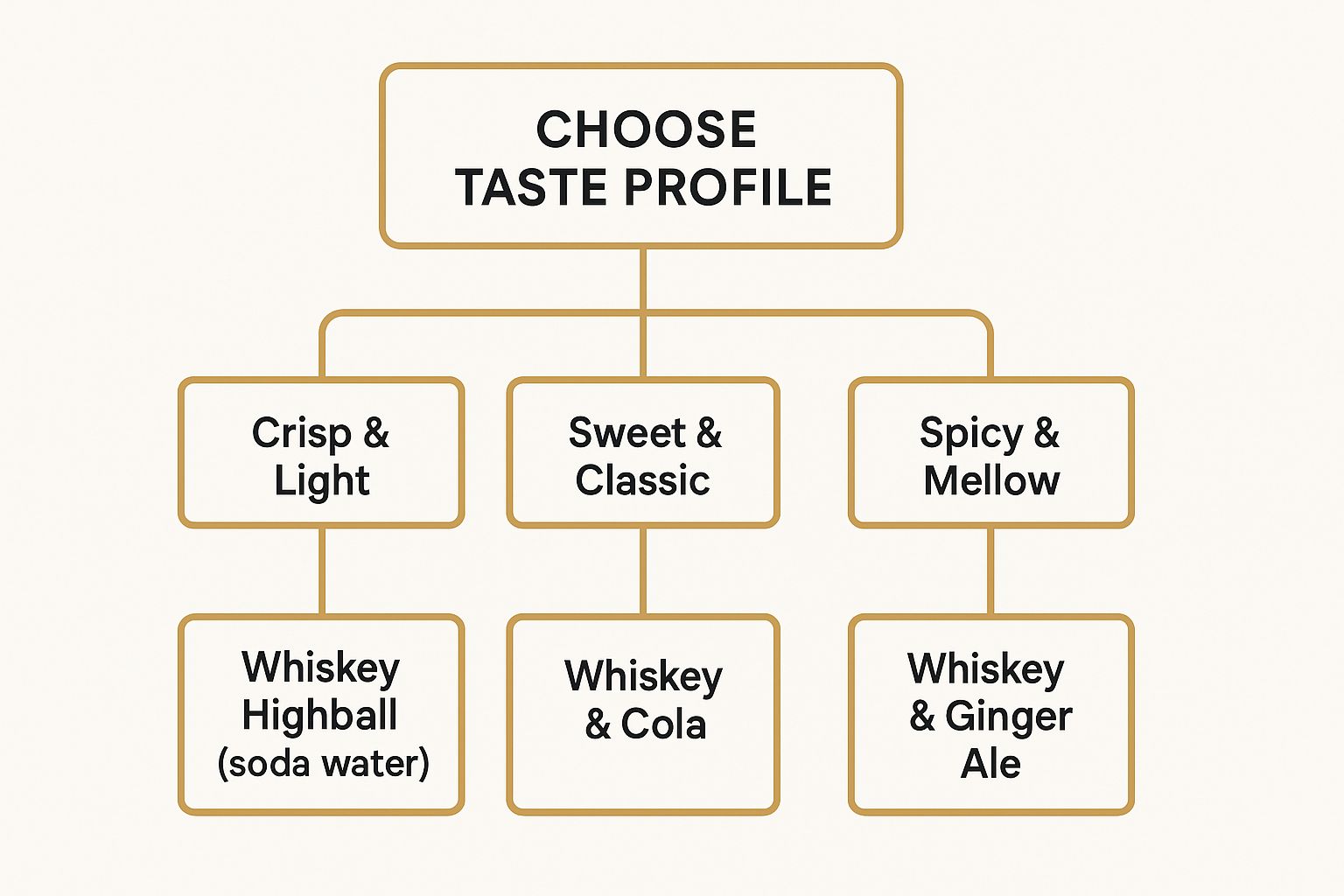
This visual guide simplifies the choice, directing you to a classic pairing whether you're in the mood for something crisp, sweet, or spicy.
How to Make a Whiskey Highball
Creating a great highball is about technique and balance, not just pouring two liquids together. The key is to keep everything cold and crisp.
- Choose Your Whiskey: You don't need a top-shelf bottle. A quality mid-range bourbon or rye, like those from many American craft distilleries, works perfectly. Well-known pairings include Jack Daniel's and Coke or Seagram's 7 and 7-Up.
- Build in the Glass: Fill a tall, narrow glass (a highball or Collins glass) completely with ice. This keeps the drink colder longer and slows dilution.
- Pour & Top: Add the whiskey first, then slowly pour your chosen mixer down the side of the glass to preserve carbonation. A classic Japanese highball ratio is one part whiskey to about two or three parts soda water.
- Stir Gently: Give it a single, gentle stir to combine the ingredients without losing the fizz. Garnish with a lemon or lime wedge to add a bright, citrusy aroma.
New Drinker Tip: Elevate your highball by using premium mixers. Brands like Fever-Tree or Q Mixers use high-quality ingredients and better carbonation, which makes a noticeable difference. A great mixer makes an entry-level whiskey taste fantastic.
Mixing is a fantastic way to explore the different ways to drink whiskey without being overwhelmed by a spirit's full proof. For those just starting their journey, a highball offers a gentle introduction to a whiskey's fundamental character. To find unique American craft spirits perfect for mixing, check out the curated selections from Blind Barrels.
7. Cask Strength/Barrel Proof
Drinking whiskey at cask or barrel strength is the most direct and potent way to experience the spirit. This method involves enjoying the whiskey at the exact proof it was aged to inside the barrel, without the standard dilution process that brings most whiskeys down to 40% ABV (80 proof). Cask strength expressions, typically ranging from 50% to 65% ABV (100-130 proof), deliver an undiluted, intense, and deeply complex flavor profile.
This approach has become a favorite among devoted whiskey enthusiasts seeking maximum flavor impact. It represents the whiskey in its purest, most uncompromising form, just as the master distiller would taste it straight from the barrel. Renowned examples include Booker's Bourbon, and many American craft expressions like those from Stellum Spirits that showcase the full power of their grains and barrels.
How to Drink Cask Strength Whiskey
Approaching a high-proof whiskey requires a bit of technique to manage the intensity and unlock its layered flavors. The goal is to tame the alcohol "hug" without losing the rich character.
- Let it Rest: Pour the whiskey and let it sit for 5 to 10 minutes. This allows some of the volatile alcohol to evaporate, making it easier to nose and revealing more of the underlying aromas.
- Nose with Caution: Keep your mouth slightly open and bring the glass to your nose slowly. The high ABV can be overpowering, so gentle nosing is key to detecting notes beyond the initial ethanol vapor.
- Take a Tiny First Sip: Your first sip should be very small, just enough to coat your tongue. This prepares your palate for the high proof, preventing it from being overwhelmed.
- Add Water Drop by Drop: After tasting it neat, add a few drops of water with a straw or dropper. Swirl and taste again. Continue this process until the flavors open up perfectly for your palate. This gradual dilution is one of the most rewarding ways to drink whiskey, as it reveals new notes with each drop.
New Drinker Tip: As a beginner, think of cask strength whiskey as a flavor concentrate. Your goal isn't to drink it at full power but to use water to dilute it to a strength you find delicious. Don't feel pressured to drink it at full strength; the art is in finding the perfect level of dilution for you.
Engaging with a cask strength whiskey is a dynamic experience that puts you in control. It offers a powerful glimpse into the heart of the spirit. To dive deeper into this potent style, explore our guide explaining exactly what is cask strength whiskey.
7 Ways to Drink Whiskey Compared
| Drinking Method | Implementation Complexity | Resource Requirements | Expected Outcomes | Ideal Use Cases | Key Advantages |
|---|---|---|---|---|---|
| Neat (Straight) | Very simple | Just whiskey and appropriate glassware | Full flavor, aroma, and alcohol intensity | Experienced drinkers, tastings, premium whiskeys | Purest flavor, maximum aroma, no dilution |
| On the Rocks (With Ice) | Simple | Whiskey, ice cubes, rocks/old-fashioned glass | Chilled, progressively diluted, mellowed flavor | Casual drinking, bourbon/rye, hot weather | Reduces alcohol burn, reveals hidden flavors |
| With Water (Diluted) | Moderate | Whiskey, room temp or cool water | Enhanced aromas, reduced alcohol burn | Cask-strength, serious tasting, educational | Customizable dilution, opens flavor profile |
| Whiskey Cocktails | Moderate to high | Whiskey, mixers (bitters, sugar, citrus), bar tools | Complex, layered, varied flavor profiles | Social gatherings, beginners, celebrations | Makes whiskey approachable, creativity, variety |
| With a Whiskey Stone/Steel Cube | Low | Whiskey stones/steel cubes, freezer | Chilled without dilution | Those wanting cold whiskey without watering down | Chills without dilution, reusable, easy maintenance |
| With a Mixer (Highball Style) | Very simple | Whiskey, soda/soft drink, ice, tall glass | Light, refreshing, low alcohol concentration | Casual drinking, parties, beginners, budget drinks | Extremely approachable, quick and easy |
| Cask Strength/Barrel Proof | Moderate to challenging | High-proof whiskey, glassware | Intense, concentrated flavor, high alcohol | Collectors, experienced drinkers, special occasions | Maximum flavor intensity, collectible, flexible dilution |
Start Your Whiskey Journey the Right Way: Blind
We've traveled through the landscape of whiskey enjoyment, from the unadulterated purity of a neat pour to the complex harmony of a classic cocktail. Each method, whether it's the gentle dilution from a single ice cube or the transformative splash of water, offers a unique lens through which to appreciate a spirit. You now have a comprehensive toolkit of ways to drink whiskey, allowing you to tailor your experience to the bottle, the occasion, and your personal mood.
The core lesson is that there is no single "correct" way, only the way that brings you the most satisfaction. Understanding how ice, water, and mixers interact with the whiskey's compounds of flavor and aroma empowers you to become your own best bartender. It’s about moving beyond simply consuming whiskey and into the realm of truly experiencing it. This journey is one of continuous discovery, where each new bottle, whether it's a bold cask strength expression or a smooth, approachable bourbon, presents an opportunity to experiment and refine your palate.
The Ultimate Path to Discovery: Your Palate
The most profound way to understand what you truly enjoy is to remove all preconceptions. Marketing, bottle design, and price tags can unconsciously influence our perceptions. The ultimate tool for discovery is your own palate, guided only by what’s in the glass. This is where blind tasting transitions from a simple exercise to an essential practice.
When you taste blind, you are giving yourself the freedom to:
- Trust Your Senses: Focus solely on the aroma, flavor, mouthfeel, and finish without any external influence.
- Identify True Preferences: You might discover you love a rye whiskey from a small craft distillery like Southern Star, even if you thought you only liked bourbon.
- Build Confidence: Learning to identify specific notes and characteristics sharpens your tasting skills and makes you a more discerning drinker.
This approach isn't just for experts; it is the most effective and enjoyable way for newcomers to build a foundation of knowledge and for seasoned enthusiasts to challenge their assumptions. It’s about celebrating the liquid itself and the incredible craft of distillers who pour their passion into every barrel, from renowned names like Frey Ranch to hidden gems across the country. The most exciting journey in whiskey isn't just about finding a good bottle; it's about finding your bottle, and the best guide for that adventure is your own unbiased taste.
Ready to put your palate to the test and discover your next favorite American craft whiskey? Blind Barrels delivers the ultimate blind tasting experience to your door, complete with four curated samples, a guided tasting mat, and the big reveal. It's the most exciting way to learn about and enjoy the diverse world of whiskey. Start your blind tasting adventure with Blind Barrels today.
